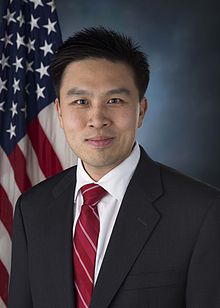Related Topics
Health (and Retirement) Savings Accounts: Steps To Lifelong Health Insurance
If you are a fast reader, we will begin with a ten-minute summary of Health Savings Accounts. At first, it covers future revenue, then spending projections follow. No matter how medical care changes, cost and revenue must remain in balance.
Right Angle Club 2017
Dick Palmer and Bill Dorsey died this year. We will miss them.
Suggested Additions.

|
| Lanhee J. Chen |
Soon after the release date of the first edition of this book, an article appeared in the Wall Street Journal by Lanhee J. Chen and James C. Capretta of Stanford University, entitled Instead of Obamacare: Giving Healthcare to the People. The authors were in general sympathy with the Health Savings Account approach and made three other suggestions with which I more-or-less agree. But they add a fourth which makes me unhappy :
1. Continuous Coverage Protection. They rightly notice many mandatory auto insurance recipients take out insurance, pay a single month's premium, during which time they obtain their drivers' license. And then no further payments are made for the insurance. The authors propose higher premiums for those who do the same thing with healthcare insurance, but presumably waive the higher cost if insurance is continued for a full year. There are many people who are suspicious of making anything mandatory, but if it's mandatory, it's unfair to allow obvious loopholes of this sort to persist.
2. Medicaid Reform. The two commenting authors are evidently aware of the unsatisfactory quality of many state Medicaid programs and propose splitting Medicaid into two parts, one for able-bodied adults and their children, and another for the disabled and elderly. Essentially, this is a rewording of high-risk pools, partially achieved by splitting Medicaid from federal plans. While this division might mesh more easily with existing workers and their families in the event of universal coverage (under a single-payer system), by itself it would not address much else.
A more useful split would be between inpatients and outpatients. That would match Medicare A and B, as well as the underlying Blue-Cross/Blue Shield organization of paperwork. Moreover, splitting helpless inpatients from ambulatory outpatients could surprisingly enable the marketplace to influence inpatient costs. Since a large number of outpatient and inpatient services are identical, it would establish a comparison framework for approximating inpatient to outpatient prices through a two-step market mechanism, which ultimately approximates market prices. For those inpatient services which have no outpatient match, a relative value system would provide a more stable way to set prices for the remainder of helpless inpatients. Doing this would close a loophole commonly employed to cost-shift inpatient costs to the outpatient area, resulting in vast confusion between two pricing systems for identical procedures. Hospital administrators would resist losing the ability to shift prices, so ultimately this is an argument about who is to dominate prices, the consumers or the providers. The "market" is a compromise between the two.
3. Medicare Reform. The main reason Medicare is often preferred to Medicaid is, it is potentially available to everyone regardless of income. But Medicare itself is 50% subsidized by the general taxpayer. No wonder Medicare doesn't need to mandate coverage. Effectively Medicare is subsidized more generously than Medicaid and thus is the main source of healthcare deficits. You might subsidize Medicaid more generously, or you could apply a 50% subsidy to a single-payer system. Either way will cost more, not less. Speaking politically, it is a question of whether you wish to offend the elderly Medicare patients or the younger indigent ones. Essentially, Congress has already chosen sides once and is unlikely to change its preference for current voters rather than potential ones. Finally, there remains one suggestion in the article which does make me uncomfortable, because of what it fails to say.
(4.) Retaining Employer Coverage. It still costs less to provide health insurance for employees, than to pay them wages and let them buy the same health insurance with what is left. Employers are therefore better off giving health insurance as a gift, even though recent inflation has held back wages more than health costs. Presumably, this anomaly would not survive tax reform, because employer-basing has turned into one big tax dodge.

|
| James C. Capretta |
But if it should survive, it presents the alternative to rectify the injustice to the other half of (small business) employees, whose employers usually cannot donate the coverage and then make it up at a spuriously higher corporate tax rate. Persisting eighty years after World War II which created the pretext, this is an unnecessary reminder of the many irregularities in the tax code. However, a one-line amendment to the HSA Law would suffice to extend the same tax exemption to outsiders, allowing other issues to remain dormant. This simple amendment would permit the premiums of a catastrophic health plan to be paid by the Health Savings Account itself, thereby extending its own tax shelter to HSA owners, at less additional commotion to the Treasury than a full exemption. The present inflation distortion should not be missed as an opportunity to restore fairness, which almost everyone now recognizes to be nothing but a lobbying plum.
Originally published: Tuesday, February 02, 2016; most-recently modified: Wednesday, June 05, 2019